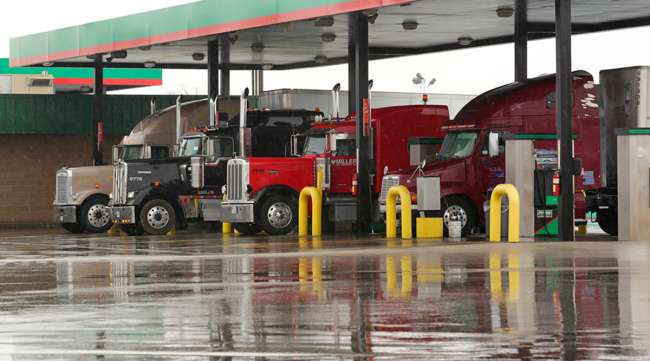Senior Reporter
Diesel Rises 1¢ to $3.079 Per Gallon

[Stay on top of transportation news: Get TTNews in your inbox.]
The U.S. average retail price of diesel rose 1 cent to $3.079 a gallon, the Department of Energy reported Jan. 6.
The same day, oil futures closed higher by less than $2 a barrel despite a sharp escalation in U.S.-Iranian tensions after the U.S. airstrike that killed the foremost Iranian general. They slipped further in the days even after the retaliatory attack by Iran on two Iraqi military sites where U.S. forces also are stationed, but no fatalities were reported. Amid the tensions, oil dipped below $60 a barrel.
U.S. average #diesel fuel price on 1/06/2020 was $3.079/gal, UP 1.0¢/gallon from 12/30/2019, UP 6.6¢/gallon from year ago https://t.co/mELgRKgBeQ #truckers #shippers #fuelprices pic.twitter.com/aq9O0mrPuF
— EIA (@EIAgov) January 7, 2020
Trucking’s main fuel costs 6.6 cents more than it did a year ago, when it was $3.013 a gallon, according to DOE.
Regional average diesel prices rose in five areas and fell in five.
The U.S. average price of a gallon of gasoline rose 0.7 cent to $2.578 per gallon, according to DOE’s Energy Information Administration.
The price is 34.1 cents higher than it was a year ago.
Average gasoline prices fell in five regions, and rose in four.
Gasoline fell the most, 2.1 cents per gallon, in the Rocky Mountain region. It rose the most, 4.3 cents, in the Lower Atlantic.
One executive at a specialized carrier said working to retain experienced drivers, which helps manage driver turnover, also can reduce the amount of fuel a carrier’s trucks use.
U.S. average price for regular-grade #gasoline on 1/06/2020 was $2.578/gal, UP 0.7¢/gallon from 12/30/2019, UP 34.1¢/gallon from year ago https://t.co/A218jSipsa #gasprices pic.twitter.com/0XQuVDmVkZ — EIA (@EIAgov) January 7, 2020
“Experienced drivers are more apt to fully utilize technology and driving skills to increase miles per gallon and lower overall fuel costs,” Roadmaster Group CEO John Wilbur told Transport Topics.
“These drivers also tend to idle less or maximize use of their auxiliary power units in order to lower fuel costs. Plus, turnover creates the need for excess empty miles when trucks need to be returned to our terminal when a driver quits. This is another source of excess fuel costs related to driver turnover,” he said.
Roadmaster Group operates 500 trucks and transports hazardous waste, and time-sensitive and high-security hauls with Fortune 500 clients. Its largest customer is the U.S. Department of Defense.
Driver turnover was about 41% at Glendale, Ariz.-based Roadmaster during 2019. “We haven’t finished totaling,” Wilbur said.
The company purchased about 7.4 million gallons of fuel last year.
Meanwhile, one oil analyst said there are 3 million to 3.5 million barrels a day of spare capacity within OPEC, which eases concerns about possible hostility-related disruptions to supplies.
“That is primarily in Saudi Arabia, but should there be a disruption, that spare capacity can be ramped up fairly quickly. Additionally, U.S. production is knocking on the door of 13 million barrels a day,” said Denton Cinquegrana, chief oil analyst at the Oil Price Information Service.
EIA reported in September and October that the United States exported more crude oil and petroleum products than it imported for the first time on record, based on monthly values since 1973. EIA’s data through December 2019 will be available by the end of February.
As for diesel prices going forward, “I think diesel will be nondramatic as far as retail prices are concerned,” he said. “Diesel supplies overall still seem to be tight relative to the five-year average.”
In addition, there has been a run on making and storing International Maritime Organization-compliant fuel ahead of its rule slashing the amount of sulfur allowed in fuel used by oceangoing vessels, which went into effect Jan. 1.
“So I think that supply needs to be worked off. So IMO effect … not yet,” he added.
In the runup to the IMO implementation date, there was concern that increased competition for cleaner diesel could cause the price of ultra-low-sulfur diesel used by trucks to spike.
West Texas Intermediate crude futures on the New York Mercantile Exchange closed at $59.91 on Jan. 9 compared with $61.68 per barrel Dec. 30.
Investors took stock of the fact that there hasn’t been a supply disruption despite escalating Mideast tensions after the U.S. assassinated Iran’s most powerful general, according to Bloomberg News. However, nervousness over the situation is denting optimism spurred by the improving outlook for global commerce, with a Sino-American trade deal expected to be signed the week of Jan. 13. While manufacturing remains weak, job markets are solid across major economies.
Want more news? Listen to today's daily briefing:




